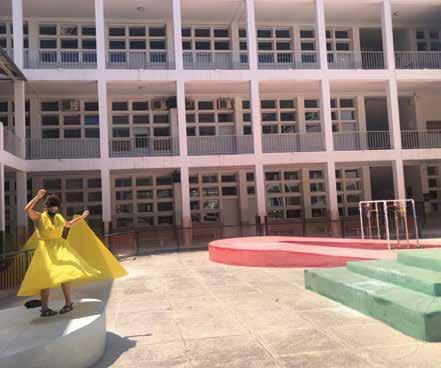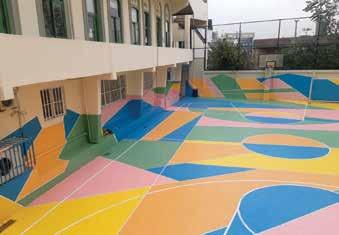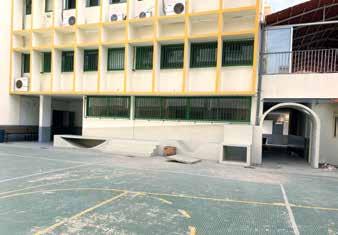
8 minute read
Playing with Sandra Al Rishani
Playing with
Sandra Al Rishani
In the wake of the port explosion, thoughts of play were far from most people’s minds. In times of turmoil, play perhaps seems superfluous, a luxury. So why were Sandra Al Rishani ‘99 and fellow architects, Nada Borgi and Etienne Bastormaji, inspired to focus on children’s play space in their post-blast reconstruction initiative Let’s Play?
Like so many others, on August 4th, Rishani’s life flipped upsidedown. As an architect and expert in urban development, her skills were in high demand from a number of organizations. She wanted to participate; however, grieving her own losses, she struggled to throw herself into these immediate relief efforts.
Sandra Al Rishani enjoying her new playspace at École Secondaire des Filles de la Charité
“You had two groups of people.” She explains. “There were people that were just not ready to deal with what had happened directly and others that just went straight to work. It was beautiful. But honestly, we [Sandra, Nada, and Etienne] were the opposite. We were super depressed and wanted to hide. We would go to meetings with all of these amazing initiatives, but we’d only help very superficially because we weren’t ready to join in so fast.” So, she and her Let’s Play colleagues took some time to process and reflect on ways they could help that would have a meaningful and lasting impact on the community. As Rishani moved around the city, she was particularly struck by the extent of the damage to the 150 schools impacted. Furthermore, she was frustrated with the emphasis on rebuilding the city exactly as it was, rather than using the opportunity as a catalyst for positive change. “Suddenly, because of the explosion, people wanted things to go back to exactly the way they were, but they weren’t that great before. The explosion was devastating, but it’s not like we had been living in heaven,” she asserts. For Rishani, one of the city’s mainissues pre-blast was its lack of public space. With a Master in Urban Development and Urban Planning from University College London, as well as a Master in Architecture from Princeton University, Rishani has long been an advocate for reimagining city landscapes and
structures as more inclusive and community-oriented spaces. Her successful Beirut-based architecture and design studio, [hatch], which she founded with Nada Borgi in 2013, focuses on context-based, “Children need environmentally-aware projects which emphasize narratives, the freedom and engagement and connection to local and global communities. time to play. Play is not a luxury, it is a Because of the breadth and severity of the damage, no one necessity. ” appeared to be talking about public space in the context of post-blast - Kay Redfield Jamison reconstruction. Understandably, it didn’t really seem like a priority. “It’s so secondary if people are homeless.” Rishani admits. However, Beirut’s lack of public spaces has long been an imminent issue. Many feel that they don’t have the right to public space, or the appropriate public spaces available to them in the city. Perhaps, Rishani posits, this is due to the fact that growing up in Lebanon, public space wasn’t ‘practiced.’ Many grow up playing in their apartments, or private gardens, rather than community parks, which are few and far between.

One of the few spaces where children actually engage in collective play is schools. While most may not have been thinking about public space or playgrounds at the time, kids, however, were still playing. Rishani and her colleagues noticed. Kids were playing all over the city, amidst the chaos and destruction, making use of anything they could find. The power of play, which educators are beginning to recognize more and more, is in the creativity it inspires. It is a primary foundation for learning, exploration, problem-solving, and communication. It helps children process emotions - the good and the bad (like trauma).
It also, the Let’s Play team believes, can be a form of resistance - a way to reclaim public space and inspire collectivism, teamwork, and growth across communities.
As they moved from school to school in Achrafieh, Gemmayze, and Mar Mikhael, Rishani, Borgi, and Bastormaji noticed that, beyond the impact of the explosion, school playgrounds were quite uninspiring and lacking. “Most schools’ playgrounds are just leftover spaces. At most, they have a canopy, and it’s usually so dull and depressing,” Rishani says.
Thus Let’s Play was born. “We decided ok. If, as a community, we want to start with public space, we also need kids to understand that playgrounds are a public space, and they can be creative ,” Rishani explained. Kids are playing anyways, so why not give them tools and elements that will help facilitate processes in a fun and engaging way? The initiative began on a very small scale. “We’d take one playground per school, create a design for it, render the design to look real, and show school principles and potential funders the work,” Rishani describes. Designing the play spaces was the
easy part - however convincing school administrators and funders presented more of a challenge.
“Generally, the attitude was that this is not a priority,” Rishani affirms. Most funding was directed towards immediate relief efforts at the time. However, with hard work and much convincing, Let’s Play finally partnered with four NGOs: Beb w Shebbek, Beit el Baraka, March, and Nussand, in addition to various private funders, who agreed to help fund and facilitate the projects. They were also concerned about the reaction of school principals. “Schools in Lebanon are very far from this idea of play as learning. In the beginning, we were like, ok, we can get the funds… but, are we going to convince the principals?” Again, play is not really seen as a priority. However, all worries subsided once the principals saw the potential designs. “They were amazed and super excited!”
Rather than present an added challenge, Covid helped move the project higher on schools’ agendas. Schools need appropriate outdoor spaces now more than ever. In addition, after two years of online classes, having a new play space to return to might help kids get a bit more excited about the return to in-person learning.
Given the current climate, logistics have been challenging, to say the least. Because of this, the playgrounds are just now being realized in their totality. Seven playgrounds are currently in the works - with three complete and four more under construction. Beb w Shebbek and Beit el Baraka are responsible for the funding and implementation of three playgrounds each. Once these are complete, the hope is that the model can be copied and reproduced at other schools in blast-affected areas and ultimately, the whole city.
The funky, abstract, and colorful nature of the playground is intentional, and a hugely important aspect of Let’s Play’s mission. The unique typologies and bold graphics (pictured below) are not the typical swings, slides,
Playground at the American Evangelical Central High School before and after Let’s Play intervention

and seesaws that one would expect to see on a playground. Rather, their abstract yet inviting nature is meant to promote experimentation and create opportunities for interaction, teamwork, and negotiation.
It was a collaborative process. Rishani, Borgi, and Bastormagi worked with a number of volunteers who helped survey sights, design the structures, and spur the team into action. “Our volunteers were really amazing,” Rishani states. “They pushed us because they were so excited. We would mention in a meeting ‘Oh, we saw this school which might have potential,’ and our volunteers would go survey it and come with sketches, and and we were like, ‘Ok, let’s do it!’” They also worked with kids in the community, who provided valuable input.“We would design things and render them, then show them to kids to get their response. That was so fun because generally the reaction was, ‘this is so cool but what do I do with it? We were like, ‘yeah this is exactly the point!’”
The structures are undoubtedly fun and engaging and brighten up the previously uninspiring play spaces. However, the ultimate goal is that, through engaging with these abstract play structures, children might realize that you don’t need a designated space or certain toys in order to play and have fun.
“Our hypothesis is that this will actually create an attitude towards play that you can play anywhere. We want to empower kids to find these voids in the city, to see that you can build a mound anywhere and you can dig a hole in an empty plot. You don’t need permission to do that. You don’t need to have a swing to call it a playground. It doesn’t have to be an exclusive space.”
Let’s Play has also partnered with architect and urban reforestation expert and advocate, Adib Dada to plant a small green space in each playground. At the École Secondaire des Filles de la Charité, for example, Dada, with the help of some students, planted small saplings in a four meter circular patch inside the play area. Hopefully in five years time, these will grow into much larger trees and will provide shade and greenery for the playground - a process from which the students can observe and learn.
Let’s Play’s efforts have not gone unnoticed. They have gained global recognition for their work and notably were featured in the New York Times
Another render currently under construction Students help plant trees


piece, ‘16 Global Design Concepts for an Unpredictable Future,’ last March.
While their main focus at the moment is schools directly impacted by the explosion, Rishani says they are ultimately hoping to intervene in public schools all around the city. “In the private schools we are working in, even if they are low income schools, there is usually some intention of garden space for the kids or something. The public schools we visited were really inadequate in terms of playgrounds. You might have a basketball court and that’s it. In theory, we would love to work with public schools all over the country.”
So are the playgrounds as fun as they look? “Oh yeah,” Sandra says, grinning. “I’ve played a lot… they are a blast!” Most importantly, kids think so too.



